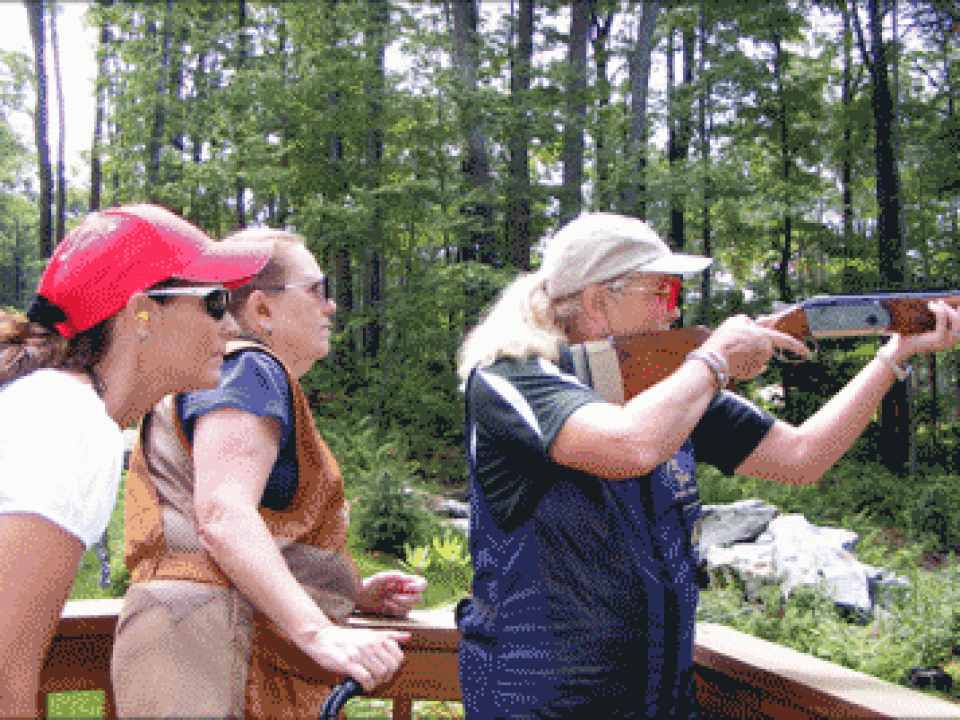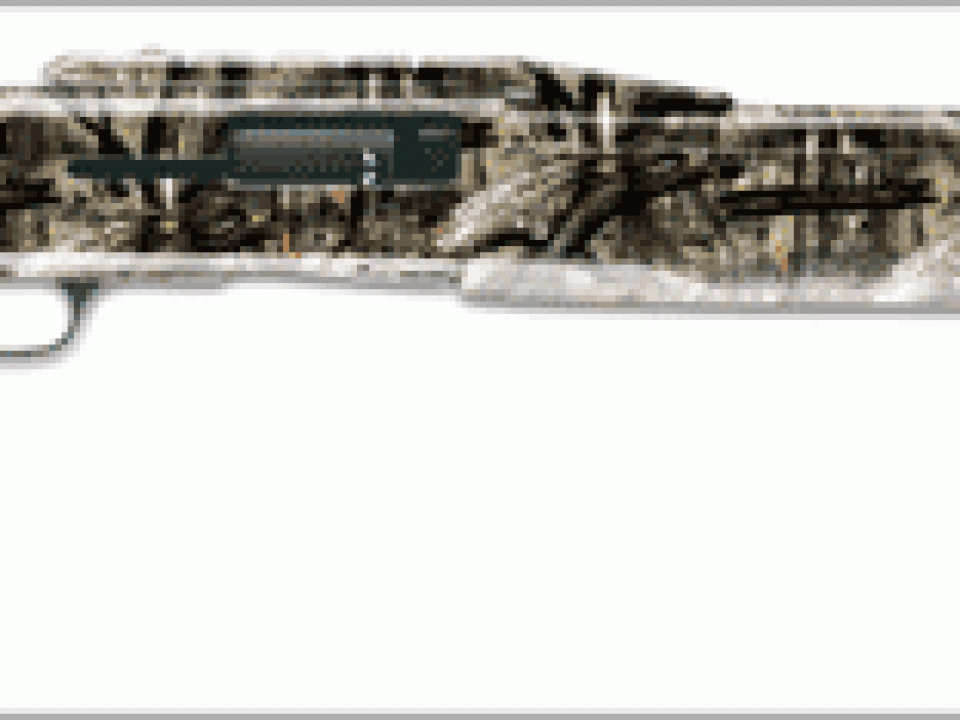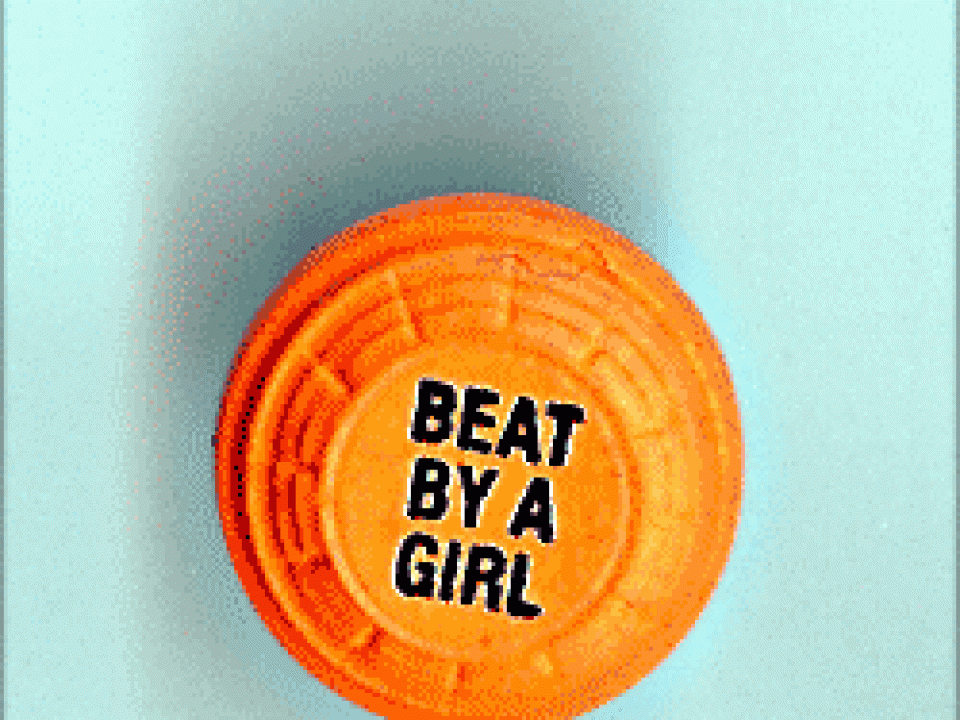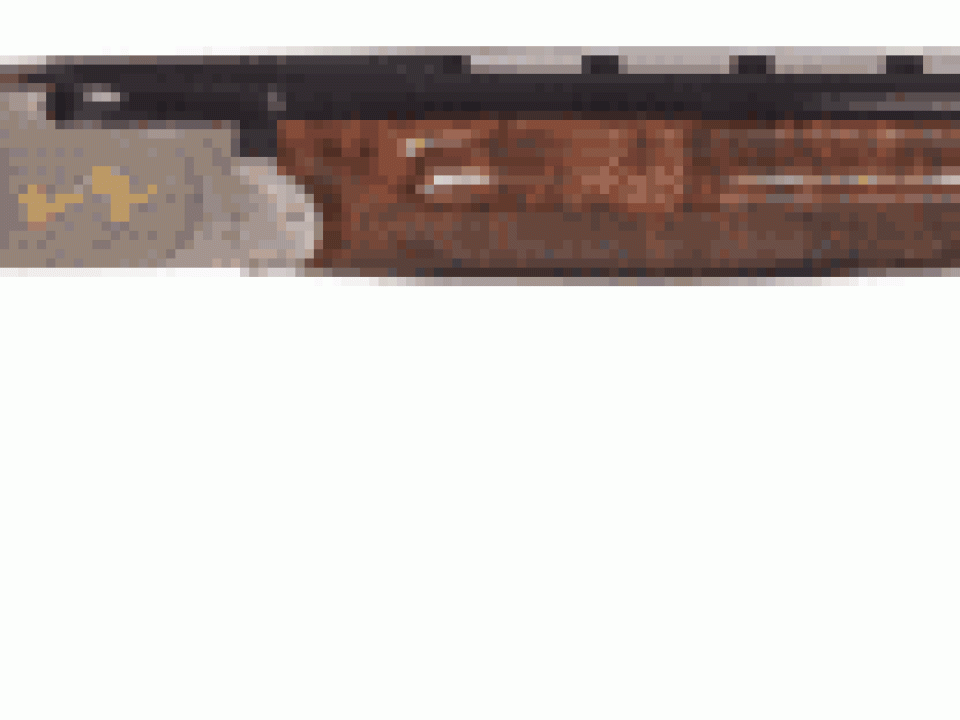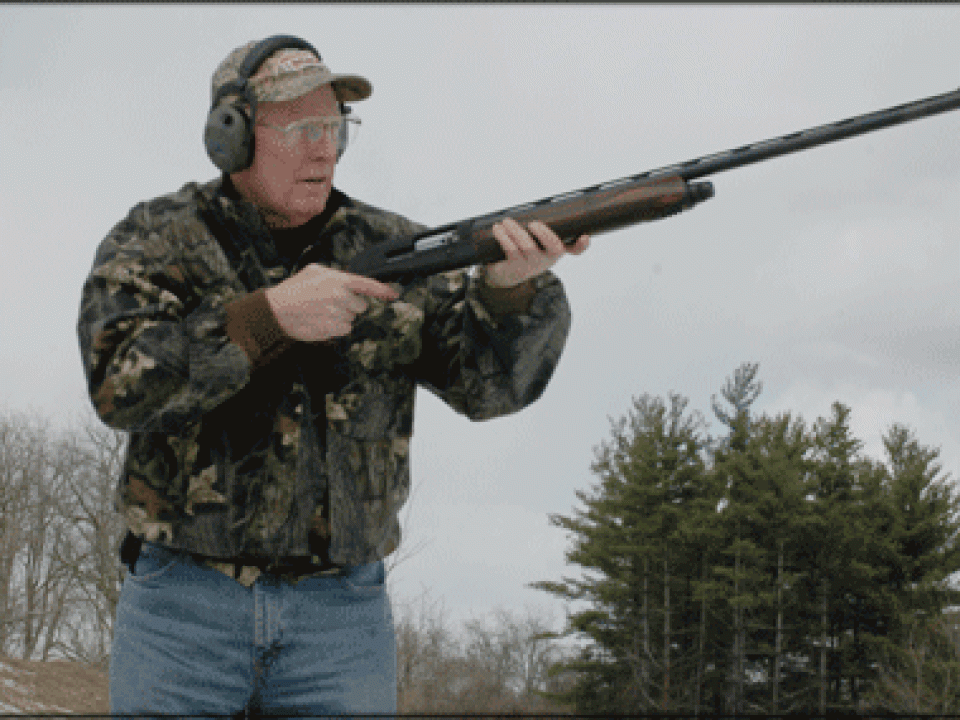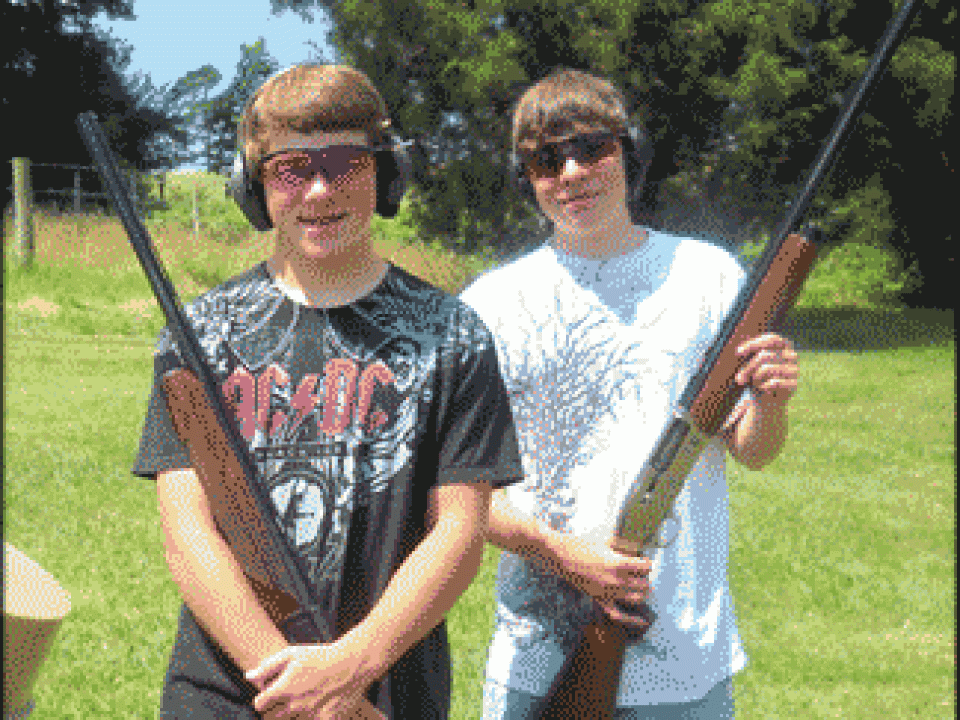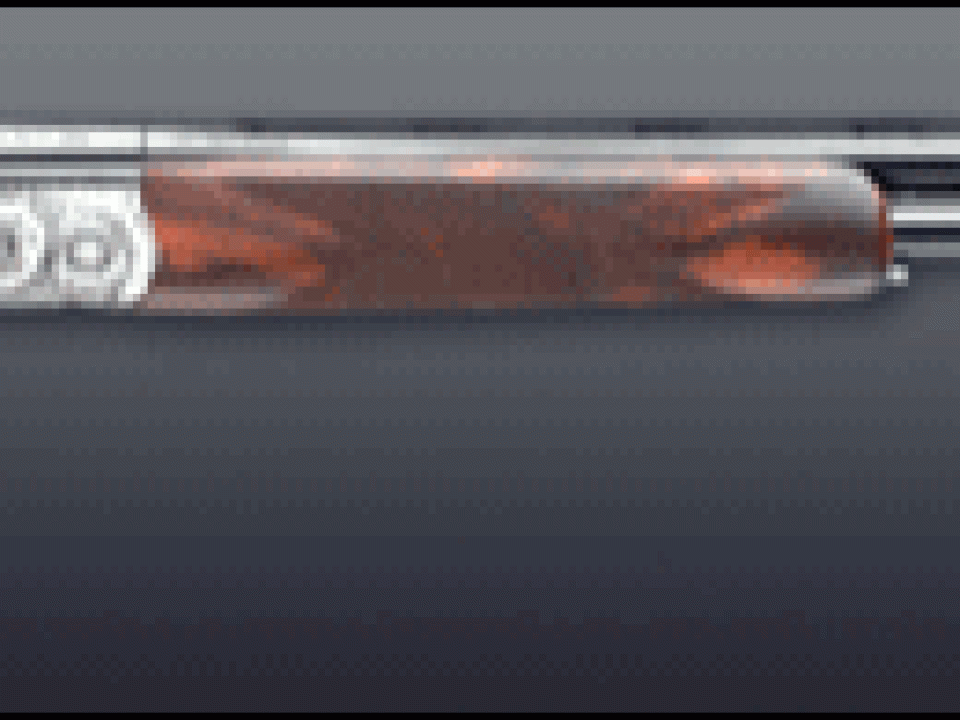If you’ve ever watched Gil and Vicki Ash on their instructional DVDs, you walk away with the feeling that you really want to spend some time with these earnest Texans. They’re smart, funny and engaging. Well, what we discovered over a 9½ hour workshop with them is that they are exactly the same people in person as they are on your TV screen.
gun
Peer Review: The Browning Silver Lightning
I’ll be the first to admit that I may have been suffering from a mid-life crisis, but ultimately I really wanted to prove that a mainstream semi-auto like the Browning Silver Lightning still had what it takes in our digital era of composite gladiators such as the Maxus and Vinci.
Beat By a Girl
Elizabeth Lanier is taking some well-deserved time off. She invited Shotgun Life Editor, Deborah McKown, to contribute a guest column this month.
Peer Review: The SKB GC7 Clays 20/28/.410 Three-Barrel Set
SKB is a shotgun company that flies under the radar of most wing and clays shooters, which is regrettable given the enthusiastic impression the GC7 Three-Barrel Set made on the Shotgun Life Peer Review Posse.
Side By Side
I have always said that if God wanted me to shoot an over under, He would have made my eyes that way. Actually, it might have been my Dad who said that first. He was a straight-shooting Yankee and I assure you, both his eyes were side by side his whole life. Dad hunted with one double-gun for his ninety-two years. It was a second-hand, 12 Ga. Tobin that he bought from a market gunner named Lincoln, in Accord, Massachusetts, back in the 1930’s. I still have that old fowling piece, and even gunned ducks with it myself in my early teens. Some day, I am going to have it restored just like new.
Me? I grew up with a 20 Ga. double in my hands. It was my own gun and I got it for Christmas when I was ten years old, back in 1972. I hunted with it until 2009, when I pulled up on a pair of incoming woodies and it failed to fire – for the first time in thirty-seven years. My Dad paid $80 for my little double at F.W. Woolworth’s when I was nearing my tenth birthday. He wrapped it up and put it under the Christmas tree and I had to wait until Christmas morning to open it. The first thing I shot and killed with it was an empty milk carton out behind the house. I started my writing career that day, and have recorded every game bird and animal I have ever taken with that gun. I remember well my first grouse, woodcock, pheasant, quail, black duck, mallard, eider, rabbit and a whole mess of other game I have hunted with that wonderful, little double because I have written it all down through the years.
My side by side fit me like a glove when I was a kid, and it grew into an extension of my body. 28” inch barrels, 14” LOP, and say what you want about a cheap double imported from Brazil, but it closed up tight as a drum. It still does. I was so comfortable with my double that it gave me a lot of confidence growing up. I remember going 21 for 21 on clays thrown from a hand trap in the sand pit, using only the rear barrel. And that meant a lot to a young boy coming of age, especially with all of his friends watching wide-eyed, and then talking it up at school. Word got around that I was a shooter and hunter and that I was a pretty good shot. I walked a little taller in the hallways between classes and kids looked at me a little differently from that day forward.
My double has seen a lot of hard use and is scratched, pitted and worn almost beyond recognition now. But if it could talk, it would tell you about all the places it’s been, including duck blinds on the Massachusetts coast, pheasants in Ohio, grouse, woodcock and snowshoe hare in Maine and New Hampshire, cottontails and beagles in Indiana, deer in New York, and a whole bunch of other places I’ve had the pleasure of carrying it.
I know you will think I am crazy, but I’m going to find a gunsmith that won’t laugh at me when I bring it by. I know it’s a cheap gun, not worth anything to anyone, but I’m going to ask him to rebuild it for me from the ground up. But one thing I am not going to have him change. I want him to leave the scratches and the worn, smooth spots just as they are. And I hope he will understand.
Capt. David Bitters is a writer/photographer and a striped bass/sea duck hunting guide from Massachusetts. His photos and essays have appeared in over one-hundred magazines. Capt. Bitters is currently finishing his first book, A Sportsman’s Fireside Reader – Tales of Hunting, Fishing, and Other Outdoor Pleasures. Contact him at captdaveb@baymenoutfitters.com or (781) 934-2838. You can also write him at P.O. Box 366 Duxbury, MA 0233.
So You’re Thinking About Buying a New Shotgun?
You probably already have some preconceived notions about your dream shotgun, and that is just fine. But sometimes it pays to seek advice from someone who has had literally hundreds of shotguns pass through their hands, had so many different stocks touch their cheek, fondled so many receivers. Lucky for me, I am one of those folks, so hopefully what I’m going to tell you might help with your future purchase.
What is the most important quality to seek in your next shotgun? A beautiful piece of walnut, out of this world engraving, strength to hold up to a million rounds, a stock that fits you perfectly? Or what? To me all these factors are important, as are others, but I think the best quality a shotgun can have is feel. That’s what to look for first.
It’s difficult to describe feel, just as it’s difficult to describe love at first sight. You just know both when you feel either. Once you love how a shotgun feels you are going to thoroughly enjoy it. You are going to have great confidence in it. After that you can always add such luxuries as a custom stock, custom engraving, custom checkering, whatever. But if you don’t start out loving the feel of a shotgun the cards are stacked against you ever shooting that gun all that well.
When it comes to semi-autos I think Beretta attained the feel I’m talking about with the models 303, the 390, and now the many versions of the 391. I don’t think it’s easy to incorporate a good-feeling quality into a semi, but I do believe Beretta has done it. It’s more than balance I’m talking about, but good balance is certainly a big part of having a shotgun feel right. A shotgun with great feel should move almost effortlessly to the target – pitch or feathered. Such a shotgun will probably let you think it actually weighs less than it really does. You should look forward to picking up and fondling such a shotgun every chance you get.
Have you ever picked up a Perazzi? If you have not done so I urge you to do that – do it even if you cannot afford one. There’s something about virtually every Perazzi I pick up that just sings feel. From the initial pick up to the shouldering to the mounting to the swinging, even to the sound of a Perazzi clicking shut – for many it is a love affair at first sight or first feel. This seems to be true no matter the barrel length for this company has a way of matching barrel weights to the receiver, stock and fore-end so that balance and feel are not compromised. To experience feel first hand just pick up and handle a Perazzi intended for field shooting – or one of their sporting clays models.
The English got feel right over 100 years ago – with their side by side shotguns, first with hammer guns, but later with sidelocks and then even boxlocks. Not many of us are going to have the opportunity to pick up, fondle and swing a Purdey or a Boss, but maybe one day you will have a chance to do this with one of the lesser known old English doubles – perhaps an Army & Navy, a Webley Scott (this company made many fine English double guns sold in other names), a Cogswell & Harrison, a Reilly or one from a number of other English makers that don’t bring the prices of a Purdey, a Holland or several others. If you ever get the chance to handle a gun like this you will see what I mean by feel.
Enough about feel – let’s move to fit. Whatever new gun you buy – it probably won’t fit you perfectly. However, this does not mean you have to change the beautiful stock the gun came with – at least hopefully not. Length of pull can be adjusted with a thicker or thinner recoil pad. If the comb is too high you or a stock person can sand away until that portion of the fit is correct, and then minimal refinishing could be all you need to fix the looks of the walnut.
You could also have the stock you buy made into an adjustable comb stock – or it may come with one. These are sort of ugly but not double ugly. You could add self-adhesive Moleskin (available at drugstores) to the comb if the stock is too low – sort of double ugly but serviceable.
The best way to determine gun fit is to have a pattern paper or steel plate to shoot at. The premise should be to shoot over and over – say at least five times – at the same pointing spot on the paper or the steel plate. Is your new gun shooting high, low, left, right or some combination of two of those? No aiming for this work. Just pull the gun up and shoot.
Don’t overlook the recoil pad. Sad to say some recoil pads put on factory shotguns these days are abominable. This is not to say such pads don’t have recoil-absorbing qualities. That’s not what I’m getting at here. A recoil pad should be a significant aid in helping with a perfect gun mount. Too many pads are a significant handicap in allowing the shooter to make a great gun mount. With some pads the consistency is simply too sticky. Those that are cause a lot of gun mounting problems. Another problem is caused by sharp pad edges, especially at the top of the pad. Consider the type of pad that has a plastic insert at the top – a feature that can be a big factor in reducing gun mounting hang ups. Further, rounded edges all around the pad help guard against sharp edges gouging into the shoulder area. The recoil pad is perhaps the most overlooked aspect of new or used shotgun buying. Of course, the buyer can always add the recoil pad of his or her choice after purchase.
For hunting, as opposed to competition shooting, I actually like most shotguns fitted with either a plastic butt plate or simply a checkered butt. These are hunting guns, most of which are shot minimally, as opposed to competition guns which are shot one heck of a lot. With a hunting gun the plastic butt pad or checkered butt stock tends to reduce back-end weight a tad – and certainly facilitates an easy, unobstructed gun mount.
In wrap up I will make one additional shotgun make suggestion for you to consider picking up, shouldering and swinging at the gun shop. This would be the Caesar Guerini, and the company makes many models, those for hunting, skeet, trap and sporting clays. This company goes to special pains to make the guns balance just ahead of the hinge pins or trunnions – and they do this regardless of barrel length. To me all the Guerini over and unders that I have handled have a great feel.
Nick Sisley has been a full-time freelance outdoor writer since 1969. He writes a regular shotgun column in Wildfowl magazine, Sporting Clays magazine, the Skeet Shooting Review and others. He’s authored eight books and penned thousands and thousands of magazine articles. He can be contacted at nicksisley@hotmail.com.
Peer Review: The Krieghoff Essencia
Even though the Krieghoff Essencia took the Silver Award at the 2003 “Gold Medal Concourse d’Elegance of Fine Guns” and won the Shooting Sportsman Award for a contemporary, custom-fitted gun that best typifies the upland hunting ideal, our Peer Review group approached the Krieghoff Essencia with a measure of skepticism.
Everyone seemed to be wondering the same thing…
Passing the Baton
As I studied our two teenage boys standing in the kitchen not too long ago, I thought they bore a strong family resemblance but they could not possibly be related to me.
The Accidental Commando
I was a very unlikely prospect, but Gary Jackson knew better.
The past President of Blackwater Worldwide and ex-Navy SEAL took one look at me and saw my inner commando. It speaks highly of his perceptive powers, because at the time my legs were ready to completely give out from under me, which is how we met in the first place.
100 Rounds of Sporting Clays With the Stunning Caesar Guerini Apex
Shooting 100 rounds of sporting clays with the new Caesar Guerini Apex is best summed up by how the gun performed on the last station: I crushed a pair of teals with a single shot.
Even my shooting partners, made up of Blaser F3 and Beretta owners, were impressed with the incredible target-crushing power of the Guerini Apex. Like so many other shooters who appreciate fine shotguns, they heard the advanced buzz over the Guerini Apex but never had the privilege of actually seeing one in action.
These highly coveted shotguns have been in short supply since their introduction at the 2009 Shot Show, held January 15-18 in Orlando, Florida. Recently, shipments of the new Guerini Apex have started trickling into the U.S. from the factory in Brescia, Italy.
I managed to get one of the few Guerini Apex Sporting Models on the sporting clays course thanks to Bart’s Sports World in Glen Burnie, Maryland. The three Bart brothers – Jack, Wayne and Roy – live close to Caesar Guerini’s U.S. headquarters in Cambridge, Maryland. In fact, one morning I called over there Wayne was making his usual rounds on behalf of his customers.
The Guerini Apex is a premium shotgun. It ranks under Guerini’s most expensive Forum in the Caesar Guerini lineup. Although the Guerini Apex is not the top model, it exudes a transcendental vibe unlike any Caesar Guerini I’ve ever shot.
A round of sporting clays with the Guerini Apex delivers an epiphany by defining the benchmark for a $7,500 shotgun. The Guerini Apex makes you feel like every target moves in slow motion and is simply there to be pulverized.
I put the Guerini Apex through its paces at Schrader’s Bridgetown Manor, in Henderson, on Maryland’s fabled Eastern Shore. Schrader’s is known locally for its challenging course. The stations are in wooded surroundings, with mottled sunlight and plenty of natural obstacles. Schrader’s rabbit targets seem to be powered by afterburners and bounce like they are cam-shaped. Schrader’s outgoing targets tend to be slower than at other courses, but far more acrobatic and elusive as they seek the trees.
I shot 100 rounds with Roy Bart, Bart’s store manager, Al Koch and three of their shooting buddies. Wednesday mornings at Schrader’s is a weekly ritual for them, followed by lunch at the Batter Up in nearby Ridgely, and then perhaps a second round of sporting clays at Schrader’s.
The Guerini Apex I shot possessed every attribute that sets the gun apart from the other Caesar Guerini shotguns, except that for some odd reason this one had arrived from Italy with standard quality wood uncharacteristic of the figured, hand-rubbed walnut you should expect. So rather than upgrade the wood, it was turned into a demo gun. That said, it displayed a flawless wood-to-metal finish and everything about this particular Guerini Apex was a testament to quality craftsmanship.
The 32-inch over/under barrels and Prince of Wales-style forend all fit into place with no trauma or struggle. The two IC chokes screwed in effortlessly even though the threads had never been touched by oil. I then grabbed four boxes of Estate #8, 1-ounce loads and was ready to shoot.
Since Shotgun Life was the first publication to cover the Guerini Apex prior to its unveiling at the January 2009 Shot Show, it was nice to also be the first to write about actually using the gun.
In my visit to Caesar Guerini prior to the Shot Show, I had spent about two hours with Wes Lang, president of the company. Wes had filled me in about what to expect on the Guerini Apex, but no gun was available for me to handle.
Now, all of that has changed…
Although the Guerini Apex shares the actions, barrels and accessories with other Caesar Guerini shotguns, it benefits from new high-tech applications that we’ll probably see in future enhancements to the Caesar Guerini family.
The Guerini Apex combines laser, EDM (electrical discharge machine) hand engraving and other techniques to yield deep, elaborate patterns on the full sideplates. In the case of the Guerini Apex, the results are a stunning marriage of floral and scroll patterns with gold details on a polished coin finish. The full coverage of the engraving continues beyond the frame to the trigger guard, extended tang and forend hardware.
By using trunnions instead of hinge pins, and a “blind” sideplate mounting, Caesar Guerini receivers are free of the visible screws and hinges that can detract from the engraver’s art. That’s why the Guerini Apex can present a museum-quality sideplate on a shotgun that starts for under $10,000.
The integrity of design also extends to a trigger guard that eliminates screws, as it joins seamlessly with the elongated tang devoid of screws, which dovetails into a skeletal grip cap fastened by two screws. In effect, it’s a minimalist industrial rendition of an old-world, best gun approach.
The continuous ribbon of engraved metal from the trigger guard to grip cap creates an elegant line through the swept-back pistol grip. The stunning cosmetics are more than skin deep. As I discovered, the motif also gives the shooter a smooth, ergonomic grip that enhances the shotgun’s handling.
Caesar Guerini Apex Tale of the Tape | |
Gauge | 12 |
Barrel length | 30”, 32”, 34” |
Avg. Weight* | 7lbs. 14oz. – 8lbs. 4ozs |
Receiver finish | Coin finish, urethane coated |
Stock Finish | Hand rubbed oil |
Checkering | 26 lines per inch |
Recoil Pad | Black rubber |
Chamber | 2.75″ |
Top Rib | 10mm (.4”) Parallel |
Center Rib | Ventilated |
Forcing Cones | 5” DuoCon |
Avg. Barrel Weight | 30” (3.28lbs), 32” (3.35lbs.), 34” (3.44lbs.) ** |
Avg. Bore | .735, Chrome lined |
Chokes | 6 MAXIS competition chokes |
Sight(s) | White Bradley style front, brass center bead |
Fore-end | Rounded |
Trigger | Single selective, adjustable for length of pull |
Safety | Manual (Automatic as an option) |
Accessories | Stock and trigger wrench, choke case, friction choke wrench. |
Case | Plastic and leather hard case with fit interior. Source: Caesar Guerini |
* Weight may vary based on wood density.
** Special order only through the Caesar Guerini Custom Shop
Mind you, the feel of the Guerini Apex won’t be mistaken for a round-body FAMARS Excalibur, but I will say that in a blind test the Guerini Apex would probably emerge as the most comfortable shotgun among its peers.
Out on the sporting clays course, one of my immediate reactions to shooting the Guerini Apex was how sturdy it felt. The Caesar Guerini boxlock actions are machined from solid billets of steel and alloys. This process provides both stronger actions and better recoil absorption. That’s one of the reasons why shooting 100 rounds of 1-ounce loads never bothered me.
The inertia trigger group on the Guerini Apex felt crisp enough that it contributed to a more aggressive and confident shooting style. Caesar Guerini’s triggers are designed for reduced friction. Marry that with the inspiring ergonomics of the Guerini Apex and the gun seemed hard-wired to my brain for nailing that critical point of impact in the more difficult presentations at Schrader’s.
One particular station featured a simo-pair consisting of a fast quartering away bird flying straight for the trees, followed by a much slower looper suddenly popping out from a bush about 15 feet in front of me before plunging into tall weeds.
Instinct dictates that you go after the fast quartering away bird, thinking that the slower looper would be the natural second shot. That wasn’t the case. It took a lot of patience and gun control to wait for that looper to finally appear, smash it first, then track the quartering away bird as it transitioned into a low, fast, 20-yard shot.
The new Prince of Wales-style forend on the Guerini Apex gave me the superior control in a shot that demanded a combination of nerve-wracking patience followed by a burst of speed.
Making its debut at Caesar Guerini, the Prince of Wales-style forend replaces the Schnabel forend on other Caesar Guerini models. In comparison to a Schnabel forend, the Prince of Wales-style forend tapers toward the muzzle and eliminates the lip on the leading edge of the forend to create a more organic contour.
Like forends on other Caesar Guerinis, the Guerini Apex features an Anson pushrod forend latch. It appears as a small button on the nose of the forend. It’s recognized for three significant benefits: By eliminating the big external latch used by most other gunmakers, the checkering can wrap completely around the forend for a more secure grip. In addition, it’s self-adjusting over time. Finally, there are fewer working parts to deteriorate.
The payoff of this beautiful forend is a steady left hand in waiting for a slow looper plus the effortless handling in establishing and crushing the second, faster quartering away bird.
As we made our way through the sporting clays course, it became increasingly obvious that the Guerini Apex was an extraordinary shotgun. My squad-mates repeatedly praised some of the more difficult shots I had made with it. But for me, it was a shot made by Al that truly opened my eyes to the gun’s superiority.
We were at a station where rising outgoers were thrown from a hand trap: two reports followed by a simo pair. They were pretty much lay-ups, but for whatever reason Al missed one bird in the simo pair. After we had all shot, Al asked the trapper to throw him another simo. Al totally crushed the birds and I immediately thought, wow, I hadn’t seen Al hit targets that hard all morning. When Al turned around he raised the Guerini Apex in a triumphant thrust. Until that point, I had no idea he was using it for that shot.
What was it about the Guerini Apex that made it feel so special?
I will say that the Guerini Apex I used felt more balanced than the other 12-gauge Caesar Guerinis I’ve shot. It could have been the density of the wood or any combination of factors, but the gun performed as though all the incremental improvements made to the Caesar Guerini family of shotguns had been unified in the Guerini Apex. There’s a sense that the Guerini Apex is the culmination of the entire Caesar Guerini aesthetic and philosophy.
Its perfect center of gravity, clean elegance of the design and that touch of Italian magic gave the Guerini Apex the authority and poise rarely found in a production shotgun for under $10,000.
If you’re interested in a Guerini Apex, the manufacturer’s suggested retail price is $7,550. Standard options include $200 for a left-hand stock and $120 for an English Stock.
You can also consign your Guerini Apex to the company’s new Custom Shop for upgrades such as the D.T.S Kinetic Balancer, custom engraving, bespoke stocks, adjustable recoil pads or anything else a proud new owner could desire.
Irwin Greenstein is Publisher of Shotgun Life. You can contact him at
letters@shotgunlife.com.
Useful resources:
http://www.schradershunting.com
Shotgun Life Newsletters
Join an elite group of readers who receive their FREE e-letter every week from Shotgun Life. These readers gain a competitive advantage from the valuable advice delivered directly to their inbox. You'll discover ways to improve your shooting, learn about the best new products and how to easily maintain your shotgun so it's always reliable. If you strive to be a better shooter, then our FREE e-letters are for you.
About Shotgun Life
Shotgun Life is the first online magazine devoted to the great people who participate in the shotgun sports.
Our goal is to provide you with the best coverage in wing and clays shooting. That includes places to shoot, ways to improve your shooting and the latest new products. Everything you need to know about the shotgun sports is a mouse-click away.
Contact
Irwin Greenstein
Publisher
Shotgun Life
PO Box 6423
Thomasville, GA 31758
Phone: 229-236-1632

